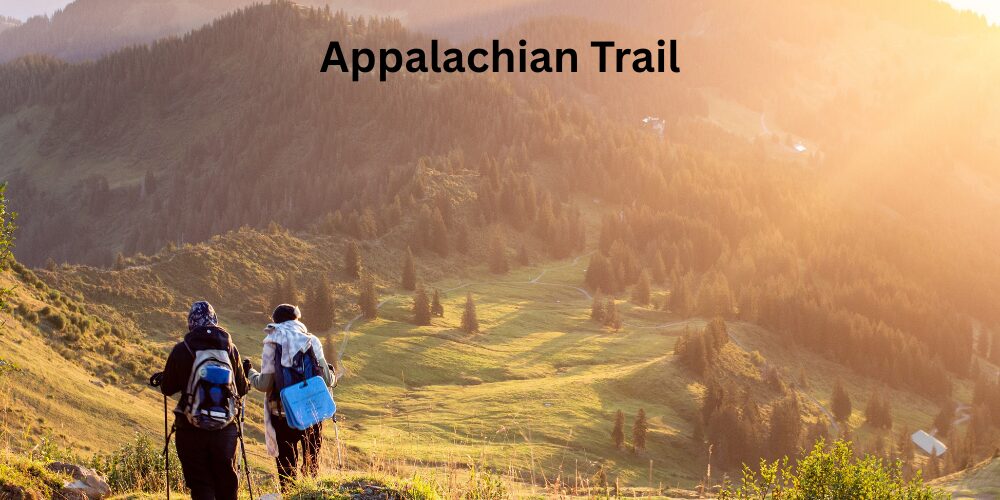The Appalachian Trail: America’s Great Walk in the Woods
There’s a quiet magic that lives along the Appalachian Trail (AT)—a thread of wildness, history, and human determination that weaves its way through 14 states, from the misty peaks of Georgia to the granite heights of Maine. At over 2,190 miles, the AT is not just a footpath; it’s a pilgrimage, a rite of passage, and one of the greatest long-distance hiking trails on Earth

Each year, thousands of people set out to hike a portion of the trail. Some are thru-hikers, aiming to complete the entire trek in one go. Others are section hikers or day trippers, drawn to a particular summit, shelter, or moment of solitude. But all who walk the trail are changed by it.
To walk the Appalachian Trail is to encounter the backbone of the eastern United States—not just its geography, but its spirit.
Click here for a Full Day Hike to Charlies Bunion on the Appalachian Trail.
From Springer to Katahdin: The Trail’s Span
The Appalachian Trail begins (or ends) at Springer Mountain in Georgia, a nondescript yet sacred summit nestled in the Chattahoochee National Forest. From there, it winds through the lush, humid woods of the South, climbing into the Smoky Mountains, crossing the rolling hills of Virginia, traversing the rock-strewn ridges of Pennsylvania, and eventually reaching the windswept alpine zones of New Hampshire and Maine.
The journey concludes (or begins) at Mount Katahdin, a weather-beaten monolith that towers over Maine’s Baxter State Park. For many, reaching Katahdin after months on the trail is the emotional climax of an extraordinary personal journey—a mountaintop moment in every sense.
The trail climbs more than 464,000 feet in elevation over its course—equal to ascending Mount Everest 16 times. Yet it’s not just the physical challenge that draws hikers. It’s the promise of freedom, introspection, and connection.
Click here for Appalachian Trail, Mountain Hiking Tours from New York City.
A Trail of Stories and Solitude
Though millions of boots have tread its path, the Appalachian Trail never feels crowded for long. One moment you might be chatting with fellow hikers over instant oatmeal at a lean-to shelter, and the next you’re alone for hours, with only the rustle of leaves or a distant woodpecker for company.
The AT isn’t just a walk in the woods—it’s a walk through time. You pass Civil War battlefields, colonial towns, and centuries-old footpaths once used by Indigenous peoples. In places like Harpers Ferry, West Virginia—the spiritual midpoint of the trail—you can trace layers of American history through cobblestone streets and preserved buildings.
Even the rocks tell stories. In Pennsylvania, hikers famously grumble about the “ankle-breaking” rocks, while in Vermont and New Hampshire, trails become muddy gauntlets and granite staircases. In the Great Smoky Mountains, cloud-wrapped balds open to 360-degree views that take your breath away—even if your legs already have.
Click here for a great selection of stylish, practical and outdoor appropriate menswear.
The Thru-Hiker’s Life
To attempt the full trail—what’s known as a thru-hike—is to step away from ordinary life and enter a simpler world, dictated by miles, weather, and instinct. Hikers adopt trail names—like “Sunshine,” “Blaze,” or “Wanderer”—shedding their real-world identities like old skin.
Daily routines revolve around packing up camp, filtering water, and logging 10 to 20 miles. Meals are often freeze-dried or cobbled together from gas station snacks and small-town resupplies. Yet, it’s a life many come to love. Days blur into a rhythm of footfall and forest, of effort and awe.
And the people? They become family. The trail community—a mix of fellow hikers, volunteers, and “trail angels” who provide unexpected kindness—forms one of the AT’s most treasured aspects. A cold soda left in a creek, a free ride to town, or a dry bunk during a storm can feel like miracles.

Nature in Its Many Moods
The Appalachian Trail isn’t flashy. There are no geysers or red rock canyons. Instead, it offers subtler, more enduring beauty.
You’ll walk beneath cathedral-like canopies of oak and maple, through fields of trillium and wild blueberries, over boardwalks that span bogs and wetlands, and across knife-edge ridges where the wind howls like an ancient spirit. In autumn, the trail explodes into reds, oranges, and golds. In spring, it’s green tunnels and rhododendron blooms.
Click here for a private 3 day aerial safari.
Wildlife is ever-present: white-tailed deer, black bears, barred owls, salamanders, and timid foxes are frequent companions. In Maine’s 100-Mile Wilderness, you may not see another soul for days—but you’ll hear the silence humming with life.
The weather, too, is a constant character on the trail. Sudden storms, bone-soaking humidity, or freezing rain can test your endurance. But then, a clear morning or a sun-drenched summit rewards you tenfold.
Landmarks and High Points
Some of the Appalachian Trail’s most iconic highlights include:
- Clingmans Dome (TN): The highest point on the trail at 6,643 feet, offering sweeping views of the Smokies.
- McAfee Knob (VA): The most photographed spot on the AT, with its iconic rock ledge.
- The Roan Highlands (NC/TN): Rolling balds with wildflowers and panoramic views.
- The White Mountains (NH): Brutal but beautiful alpine terrain, home to Mount Washington.
- Mahoosuc Notch (ME): Often called “the toughest mile,” this boulder-filled stretch is a crawl, climb, and puzzle all in one.
Click here to learn about the drive of your dreams on Californias Pacific Coast Highway.
Why People Walk It
Ask a dozen thru-hikers why they’re walking the AT, and you’ll get a dozen different answers.
Some come to heal—from loss, burnout, or heartbreak. Others come to challenge themselves, to reconnect with nature, or to take a break from modern life. Some simply seek the joy of walking, of waking up each day with a goal and a trail ahead.
But by the end, almost all will tell you that the AT changes them. You come face to face with your limits, your resilience, your fears, and your joys. You discover how little you really need and you learn to appreciate hot food, clean socks, and dry weather in a new light.
And perhaps most importantly, you learn to be present.
Click here for a New Yort to Montauk fly fishing tour.
Preserving the Path
Maintaining the Appalachian Trail is a massive community effort. Over 30 volunteer trail clubs and the Appalachian Trail Conservancy (ATC) work tirelessly to preserve this national treasure. Trail work includes repairing erosion, maintaining shelters, clearing brush, and educating hikers on Leave No Trace principles.
The AT is also a National Scenic Trail, protected under federal law, yet it’s always at risk—from development, climate change, and overuse. Respecting the trail and helping preserve it ensures future generations can walk these same forested corridors.
A Trail for Everyone
You don’t have to be a hardcore backpacker to experience the Appalachian Trail. With thousands of access points, anyone can step onto it for a few hours, a weekend, or a summer. Whether it’s a sunrise hike to Blood Mountain or a family stroll near Bear Mountain Bridge, the trail welcomes all who walk with care.
Click here for a day trip from Manhattan to Niagara Falls by private helicopter.
Conclusion: A Path Through America’s Soul
The Appalachian Trail is more than a long hike. It’s a journey through landscapes both external and internal. Through history, heartache, and harmony. Through fog, fireflies and the simple, powerful act of walking.
It’s not just a footpath in the woods—it’s a pathway into the soul of America, and perhaps into your own.

